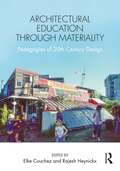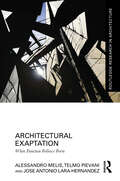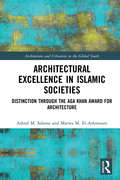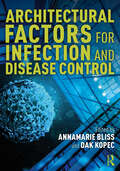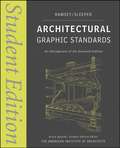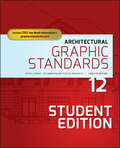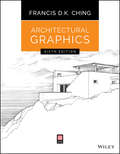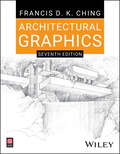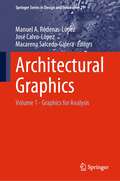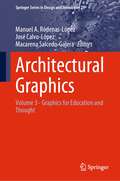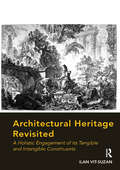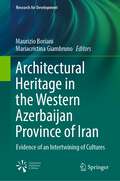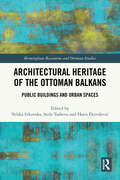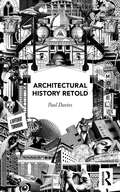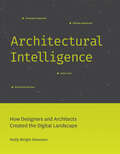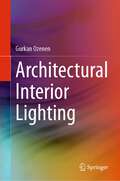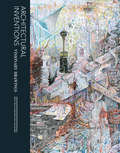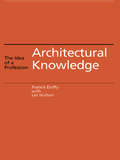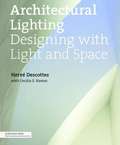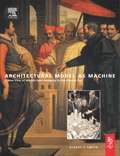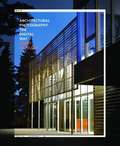- Table View
- List View
Architectural Education Through Materiality: Pedagogies of 20th Century Design
by Elke CouchezWhat kind of architectural knowledge was cultivated through drawings, models, design-build experimental houses and learning environments in the 20th century? And, did new teaching techniques and tools foster pedagogical, institutional and even cultural renewal? Architectural Education Through Materiality: Pedagogies of 20th Century Design brings together a collection of illustrated essays dedicated to exploring the complex processes that transformed architecture’s pedagogies in the 20th century. The last decade has seen a substantial increase in interest in the history of architectural education. This book widens the geographical scope beyond local school histories and sets out to discover the very distinct materialities and technologies of schooling as active agents in the making of architectural schools. Architectural Education Through Materiality argues that knowledge transmission cannot be reduced to ‘software’, the relatively easily detectable ideas in course notes and handbooks, but also has to be studied in close relation to the ‘hardware’ of, for instance, wall pictures, textiles, campus designs, slide projectors and even bodies. Presenting illustrated case studies of works by architects, educators and theorists including Dalibor Vesely, Dom Hans van der Laan, the Global Tools group Heinrich Wölfflin, Alfons Hoppenbrouwers, Joseph Rykwert, Pancho Guedes and Robert Cummings, and focusing on student-led educational initiatives in Europe, the UK, North America and Australia, the book will inspire students, educators and professionals with an interest in the many ways architectural knowledge is produced and taught.
Architectural Exaptation: When Function Follows Form (Routledge Research in Architecture)
by Telmo Pievani Alessandro Melis Jose Antonio Lara-HernandezArchitectural Exaptation: When Function Follows Form focuses on the significance and the originality of the study of exaptation. It presents exaptation as an opportunity to extend architectural design towards more sustainable approaches aimed at enforcing urban resilience.The use of exaptation’s definition in architecture supports the heuristic value of cross-disciplinary studies on biology and architecture, which seem even more relevant in times of global environmental crises. This book aims to make a critique of the pre-existing and extensive paternalistic literature. Exaptation will be described as a functional shift of a structure that already had a prior, but different, function. In architecture, a functional shift of a structure that already had a function may apply to forms of decorative elements embedded in architectural components, and to both change of function of tectonic elements and the change of use of an architectural space. The book is illustrated with examples from around the globe, including China, Italy, Mexico, New Zealand, the USA and the UK, and looks at different civilizations and diverse historical periods, ranging from the urban to the architectural scale. Such examples highlight the potential and latent human creative capacity to change the use and functions, something that cities and buildings could consider when facing disturbances. Exaptation is shown as an alternative narrative to the simplifications of evolutionary puritanism. It also offers an innovative perspective and presents an opportunity to re-think the manner in which we design and redesign our cities.This book will be of interest to architecture, planning, urban design and biology researchers and students.
Architectural Excellence in Islamic Societies: Distinction through the Aga Khan Award for Architecture (Architecture and Urbanism in the Global South)
by Ashraf M. Salama Marwa M. El-AshmouniThis book discusses architectural excellence in Islamic societies drawing on textual and visual materials, from the Aga Khan Documentation Center at MIT, developed over more than three decades. At the core of the discussion are the efforts, processes, and outcomes of the Aga Khan Award for Architecture (AKAA). The AKAA recognises excellence in architectural and urban interventions within cities and settlements in the Islamic world which are continuously challenged by dramatic changes in economies, societies, political systems, decision-making, and environmental requirements. Architectural Excellence in Islamic Societies responds to the recurring question about the need for architectural awards, arguing that they are critical to validating the achievements of professional architects while making their contributions more widely acknowledged by the public. Through analysis and critique of over sixty awarded and shortlisted projects from over thirty-five countries, this book provides an expansive look at the history of the AKAA through a series of narratives on the enduring values of architecture, architectural and urban conservation, built environment sustainability, and architectural pluralism and multiple modernities. Architectural Excellence in Islamic Societies will appeal to professionals and academics, researchers, and upper-level students in architectural history and theory and built environment related fields.
Architectural Factors for Infection and Disease Control
by Dak Kopec AnnaMarie BlissThis edited collection explores disease transmission and the ways that the designed environment has promoted or limited its spread. It discusses the many design factors that can be used for infection and disease control through lenses of history, public health, building technology, design, and education. This book calls on designers to consider the role of the built environment as the primary source of bacterial, viral, and fungal transfers through fomites, ventilation systems, and overcrowding and spatial organization. Through 19 original contributions, it provides an array of perspectives to understand how the designed environment may offer a reprieve from disease. The authors build a historical foundation of infection and disease, using examples ranging from lazarettos to leprosy centers to show how the ability to control infection and disease has long been a concern for humanity. The book goes on to discuss disease propagation, putting forth a variety of ideas to control the transmission of pathogens, including environmental design strategies, pedestrian dynamics, and open space. Its final chapters serve as a prospective way forward, focusing on COVID-19 and the built environment in a post-pandemic world. Written for students and academics of architecture, design, and urban planning, this book ignites creative action on the ways to design our built environment differently and more holistically. Please note that research on COVID-19 has exponentially grown since this volume was written in October 2020. References cited reflect the evolving nature of research studies at that time.
Architectural Factors for Infection and Disease Control
by Dak Kopec AnnaMarie BlissThis edited collection explores disease transmission and the ways that the designed environment has promoted or limited its spread. It discusses the many design factors that can be used for infection and disease control through lenses of history, public health, building technology, design, and education.This book calls on designers to consider the role of the built environment as the primary source of bacterial, viral, and fungal transfers through fomites, ventilation systems, and overcrowding and spatial organization. Through 19 original contributions, it provides an array of perspectives to understand how the designed environment may offer a reprieve from disease. The authors build a historical foundation of infection and disease, using examples ranging from lazarettos to leprosy centers to show how the ability to control infection and disease has long been a concern for humanity. The book goes on to discuss disease propagation, putting forth a variety of ideas to control the transmission of pathogens, including environmental design strategies, pedestrian dynamics, and open space. Its final chapters serve as a prospective way forward, focusing on COVID-19 and the built environment in a post-pandemic world.Written for students and academics of architecture, design, and urban planning, this book ignites creative action on the ways to design our built environment differently and more holistically.Please note that research on COVID-19 has exponentially grown since this volume was written in October 2020. References cited reflect the evolving nature of research studies at that time.
Architectural Graphic Standards
by Ramsey Charles George Sleeper Harold Reeve Bruce BasslerThe new student edition of the definitive architectural reference For seventy-five years, Architectural Graphic Standards has been the go-to reference for architects, builders, and engineers. Revised for the first time since 2000, Architectural Graphic Standards, Student Edition gives students their own handy resource. Carefully abridged from the Eleventh Edition of Architectural Graphic Standards, this Student Edition features the same richly detailed graphics and text that have made Architectural Graphic Standards a classic, but updated and reorganized in a way that is relevant to today's student. Thousands of illustrations and a rich index offer immediate access to hundreds of architectural elements, while the wide variety of topics covered makes this work relevant throughout a student's architecture education and into the early stages of professional practice. With a wealth of information for the student preparing for professional practice, this new edition: * Covers building standards and practices, materials and systems, and details for every type of project * Follows CSI's Uniformat, a classification system that closely matches an architect's workflow * Features completely updated content with a wide variety of standard architectural details * Offers an ancillary Web site featuring sample curriculums, student exercises, classroom projects, PowerPoint(r) slides, and more
Architectural Graphic Standards: Student Edition (Ramsey/Sleeper Architectural Graphic Standards Series #25)
by American Institute of Architects Keith E. HedgesARCHITECTURAL GRAPHIC STANDARDS THE LANDMARK UPDATE OF THE MOST RECOGNIZED STUDENT RESOURCE IN ARCHITECTURE The Student Edition of the iconic Architectural Graphic Standards has been a rite of passage for architecture, building, and engineering students for more than eighty years. Thoughtfully distilled from the Twelfth Edition of Architectural Graphic Standards and reorganized to meet the specific needs of today’s students, this fully updated Student Edition shows you how to take a design idea through the entire planning and documentation process. This potent resource stays with you through your academic experience and into your first years as a professional with thousands of useful illustrations and hundreds of architectural elements conveniently placed at your fingertips. Presented in a format closely resembling an architect’s actual workflow, this Twelfth Edition student handbook features: Completely new material on resiliency in buildings A versatile treatment written for the design studio setting and aligned with the most current curricular trends, including new and updated coverage on topics related to sustainability, digital fabrication, and building information modeling (BIM) A proven pedagogy that saves students time and ensures young professionals avoid the most common pitfalls Develop a state-of-the-art mastery of design best practices with Architectural Graphic Standards, Twelfth Edition, Student Edition.
Architectural Graphics
by Francis D. ChingThe bestselling guide to architectural drawing, with new information, examples, and resources Architectural Graphics is the classic bestselling reference by one of the leading global authorities on architectural design drawing, Francis D.K. Ching. Now in its sixth edition, this essential guide offers a comprehensive introduction to using graphic tools and drafting conventions to translate architectural ideas into effective visual presentations, using hundreds of the author's distinctive drawings to illustrate the topic effectively. This updated edition includes new information on orthographic projection in relation to 3D models, and revised explanations of line weights, scale and dimensioning, and perspective drawing to clarify some of the most difficult concepts. New examples of modern furniture, APA facilities, and presentation layout provide more up-to-date visuals, and the Reference Center features all new animations, videos, and practice exercises. Architectural graphics are key tools for conveying design through representation on paper or on screen, and this book is the ultimate guide to mastering the skill, then applying your talent to create more effective design communication. Understand multiview, paraline, and perspective drawing Master interior sections using a variety of techniques Render tonal value, enhance depth, and convey illumination Develop professional-quality layouts for presentations Architectural graphics both inform the design process and serve as the means by which a design is interpreted and built. Complete mastery of the tools and conventions is essential to the successful outcome of any project, and mistakes can cause confusion, time delays, increased costs, and possible catastrophe. Architectural Graphics is the comprehensive guide to professional architectural drawing, with insight from a leading authority in the field.
Architectural Graphics
by Francis D. ChingARCHITECTURAL GRAPHICS Architectural Graphics is the classic bestselling reference by one of the leading global authorities on architectural design drawing, Francis D. K. Ching. This seventh edition offers a comprehensive introduction to graphic tools and drafting conventions to translate architectural ideas into effective visual presentations, using hundreds of the author’s distinctive drawings to illustrate each topic. Updated throughout, this revised edition presents new beginner-friendly guidance for perspectives and sketching, updates on hand rendering and visual communication, and additional material on transitioning from analog to digital with CAD and digital drawing tools. Architectural graphics are key tools for conveying design through representation on paper or on screen. This book is the ultimate guide to mastering the skill and applying your talent to create more effective design communication, teaching how to: Understand multiview, paraline, and perspective drawing Master interior sections using a variety of techniques Render tonal value, enhance depth, and convey illumination Develop professional-quality layouts for presentations Architectural graphics both inform the design process and serve as the means by which a design is interpreted and built. Complete mastery of the tools and conventions is essential to the successful outcome of any project, and mistakes can cause confusion, time delays, increased costs, and possible catastrophe. Architectural Graphics is the comprehensive guide to professional architectural drawing, with insight from a leading authority.
Architectural Graphics: Volume 1 - Graphics for Analysis (Springer Series in Design and Innovation #21)
by José Calvo-López Manuel A. Ródenas-López Macarena Salcedo-GaleraThis book reports on several advances in architectural graphics, with a special emphasis on education, training, and research. It gathers a selection of contributions to the 19th International Conference on Graphic Design in Architecture, EGA 2022, held on June 2–4, 2022, in Cartagena, Spain, with the motto: "Beyond drawings. The use of architectural graphics".
Architectural Graphics: Volume 3 - Graphics for Education and Thought (Springer Series in Design and Innovation #23)
by José Calvo-López Manuel A. Ródenas-López Macarena Salcedo-GaleraThis book reports on several advances in architectural graphics, with a special emphasis on education, training and research. It gathers a selection of contributions to the 19th International Conference on Graphic Design in Architecture, EGA 2022, held on June 2–4, 2022, in Cartagena, Spain, with the motto: "Beyond drawings. The use of architectural graphics".
Architectural Heritage Revisited: A Holistic Engagement of its Tangible and Intangible Constituents
by Ilan Vit-SuzanBy improving our understanding of how the tangible and intangible dimensions of heritage are correlated, we could develop a relationship with heritage that goes beyond the mere act of conservation. This book argues that we need to recognize the historic monument as a tangible aspect of a holistic expression of culture that is rooted in specific spatio-temporal conditions. However, since the latter are constantly changing, it is vital to identify an implicit contradiction with the goals of conservation. As the intangible dimensions are more dynamic, driven by the transmission, reception, and advancement of knowledge, the reliance of the prevailing treatment of heritage today, conservation, ossifies this relationship. By examining three major heritage monuments - the Pantheon, Teotihuacan's Sun Pyramid and Alhambra - the book shows how these sites are the product of multiple strategies and unforeseen agents, accumulated through history. It emphasizes how these historical trends need to be better understood in order to attain a more 'organic' relationship with heritage and offers some recommendations that should be analyzed in participative processes of deliberation: the Pantheon's continuity could be extended; the Pyramid's loss, accepted; and Alhambra's exclusion, reversed. In this way, the book invites people to engage heritage from a historical understanding that is open to critical reassessment, dialogue, and cooperation.
Architectural Heritage in the Western Azerbaijan Province of Iran: Evidence of an Intertwining of Cultures (Research for Development)
by Maurizio Boriani Mariacristina GiambrunoThis book represents a reflection on the policies of preservation that were established and interventions for restoration that occurred in Iran before and in the years after the Khomeinist Revolution, as well as being an analysis of the impact that Italian restoration culture has had in the country. Research concerning the state of conservation and the ongoing restoration of the Armenian churches in the Khoy and Salmas areas is included, along with precise documentation of the observation of the two cities, their architecture and the context of their landscape. The problems of architectural restoration in present-day Iran and the compatible use of buildings no longer intended for worship are addressed. The book is bolstered by first-hand documentation obtained through inspections and interviews with Iranian specialists during three missions carried out between 2016 and 2018 and a large anthology of period texts that have only recently been made available for the first time for study in electronic form, including travel reports written by Westerners describing Persia between the 15th and 19th centuries.
Architectural Heritage of the Ottoman Balkans: Public Buildings and Urban Spaces (Birmingham Byzantine and Ottoman Studies)
by Velika Ivkovska Stela Tasheva Haris DerviševićThe Ottoman Empire's rule in the Balkans began in the late 14th century and continued until the late 19th century, and its impact on the region's history, culture, and society was significant. The systematic study of Ottoman influence in the Balkans, however, has only gained pace from the early 20th century.Architectural Heritage of the Ottoman Balkans: Public Buildings and Urban Spaces explores aspects and instances of Ottoman public architecture in the Balkans, a region that encompassed diverse populations, climates, and landscapes, all of which contributed to a wide array of architectural variations in both public and private structures. Throughout the book, a common thread emerges: the rich tapestry of Ottoman architecture in the Balkans reflects a synthesis of influences, both local and global. Ottoman, regional, and European architectural traditions intertwine to create a distinctive architectural identity that characterizes the region.This book also underscores the challenges of studying historical architecture, including language barriers and the scarcity of well-preserved records, while highlighting the importance of understanding these structures in their historical and cultural contexts.
Architectural History Retold
by Paul DaviesHow much do you know about Greek architecture? Roman? Gothic? The Renaissance? Modernism? Perhaps more importantly, do you know how these are connected or how one style evolved to become another? Or what happened historically during each of these periods? Architectural History Retold is your roadmap for your journey through architectural history. Offering a fresh take on what the author calls the ‘Great Enlightenment project’, it traces the grand narrative of western architecture in one concise, accessible volume. Starting in Ancient Greece and leading up to the present day, Paul Davies' unconventional, engaging style brings the past back to life, helping you to think beyond separate components and styles to recognise ‘the bigger picture’. The author is an academic and journalist with three decades of experience in introducing students to architectural history. The book is based on his successful entry-level course which has used the same unstuffy approach to break down barriers to understanding and engagement and inspire generations of students.
Architectural Intelligence: How Designers and Architects Created the Digital Landscape (The\mit Press Ser.)
by Molly Wright SteensonArchitects who engaged with cybernetics, artificial intelligence, and other technologies poured the foundation for digital interactivity.In Architectural Intelligence, Molly Wright Steenson explores the work of four architects in the 1960s and 1970s who incorporated elements of interactivity into their work. Christopher Alexander, Richard Saul Wurman, Cedric Price, and Nicholas Negroponte and the MIT Architecture Machine Group all incorporated technologies—including cybernetics and artificial intelligence—into their work and influenced digital design practices from the late 1980s to the present day. Alexander, long before his famous 1977 book A Pattern Language, used computation and structure to visualize design problems; Wurman popularized the notion of “information architecture”; Price designed some of the first intelligent buildings; and Negroponte experimented with the ways people experience artificial intelligence, even at architectural scale. Steenson investigates how these architects pushed the boundaries of architecture—and how their technological experiments pushed the boundaries of technology. What did computational, cybernetic, and artificial intelligence researchers have to gain by engaging with architects and architectural problems? And what was this new space that emerged within these collaborations? At times, Steenson writes, the architects in this book characterized themselves as anti-architects and their work as anti-architecture. The projects Steenson examines mostly did not result in constructed buildings, but rather in design processes and tools, computer programs, interfaces, digital environments. Alexander, Wurman, Price, and Negroponte laid the foundation for many of our contemporary interactive practices, from information architecture to interaction design, from machine learning to smart cities.
Architectural Interior Lighting
by Gurkan OzenenArchitectural Interior Lighting is an essential guide to creating well-lit, visually appealing interior spaces. The book begins with an overview of light and color theory, lighting fundamentals, and design principles. It then covers artificial, natural, decorative, and professional lighting in interior design, as well as standards and regulations, controls and systems, sustainable lighting, energy efficiency, light pollution reduction, and the use of environmentally friendly materials. With a focus on practical applications and real-world examples, this book provides readers with the tools and knowledge necessary to achieve their design goals while considering the latest trends and techniques in the field. A valuable resource for professionals and students in architecture and lighting design, it will also appeal to anyone interested in creating visually stunning and functional interior spaces.
Architectural Inventions: Visionary Drawings
by Matt BuaBorn out of the drawingbuilding.org online archive, Architectural Inventions presents a stunning visual study of impossible or speculative structures that exist only on paper. Soliciting the work of architects, designers, and artists of renown –as well as emerging talents from all over the world –Maximilian Goldfarb and Matt Bua have gathered an array of works that convey architectural alternatives, through products, expansions, or critiques of our inhabited environments.From abstract and conceptual visual interpretations of structures to more traditional architectural renderings, the featured work is divided into thematic chapters, ranging from 'Adapt/Reuse' to 'Clandestine'' 'Mobile'' 'Radical Lifestyle', 'Techno-Sustainable', and 'Worship'. Along with arresting and awe-inspiring illustrated content, every chapter also features an essay exploring its respective themes. Highlighting visions that exist outside of established channels of production and conventions of design, Architectural Inventions showcases a wide scope in concept and vision, fantasy and innovation.
Architectural Inventions: Visionary Drawings
by Matt Bua Maximilian GoldfarbBorn out of the drawingbuilding.org online archive, Architectural Inventions presents a stunning visual study of impossible or speculative structures that exist only on paper. Soliciting the work of architects, designers, and artists of renown –as well as emerging talents from all over the world –Maximilian Goldfarb and Matt Bua have gathered an array of works that convey architectural alternatives, through products, expansions, or critiques of our inhabited environments.From abstract and conceptual visual interpretations of structures to more traditional architectural renderings, the featured work is divided into thematic chapters, ranging from 'Adapt/Reuse' to 'Clandestine'' 'Mobile'' 'Radical Lifestyle', 'Techno-Sustainable', and 'Worship'. Along with arresting and awe-inspiring illustrated content, every chapter also features an essay exploring its respective themes. Highlighting visions that exist outside of established channels of production and conventions of design, Architectural Inventions showcases a wide scope in concept and vision, fantasy and innovation.
Architectural Knowledge: The Idea of a Profession
by Francis Duffy Les HuttonThese essays, written over a third of a century during a time of huge ideological, technological and methodological upheaval, witness British architecture's unceasing negotation with a vast and rigorous set of constraints and its eventual emergence as a truly modern profession - a special interest group responsive and answerable to social changes but shaped and informed by values and principles that may be on a longer cycle and perhaps a loftier plane. The backdrop to this debate is the term of presidency of the RIBA held by Francis Duffy, Chairman of DEGW, UK, between 1993 and 1995. During this period the architectural profession faced major challenges and threats. The book looks at the relationship between the architectural profession and the built environment in the context of the great political and social cycles in the British post-war period. Francis Duffy's writings provide additional insights and viewpoints to the subject.
Architectural Lighting
by Hervé Descottes Cecilia E. RamosArchitectural Lighting, the latest addition to the Architecture Briefs series, provides both a critical approach to and a conceptual framework for understanding the application of lighting in the built environment. The key considerations of lighting design are illuminated through accessible texts and instructional diagrams. Six built projects provide readers with concrete examples of the ways in which these principles are applied. Short essays by architect Steven Holl, artist Sylvain Dubuisson, and landscape architect James Corner explore the role of lighting in defining spatial compositions.
Architectural Management
by M. P. NicholsonThis book allows the construction professional to gain an insight into the fast moving subject of architectural management. Subjects covered include: organization of design and construction; Computing and the architect; quality and value engineering; performance of buildings; the public estate; professional/construction law and education and training.
Architectural Model as Machine
by Albert SmithThis book offers an explanation of why scale models are important to the design process. Albert Smith takes the reader through the history and significance of models in architecture from the magic of the Egyptian scale model to the present day.Through this description of the relationship between architecture and the scale model, Smith demonstrates the most effective process between concept and 'machine', between the idea and the final building. The great value of this book is to reveal the nature of the scale model and to unlock the tremendous potential of this design tool as a thinking and communicative advice.His chronological analysis goes on from Egypt through Rome to the relationship between the Greek paradigm scale model and then on to Medieval and Renaissance models. It concludes with the models of the Spanish architect Antonio Gaudi, the Russian Constructivists, the American architect Louis Khan and finally looks at the role of scale models in the present day through the work of the Polish/American architect Daniel Libeskind and the American Frank Gehry.
Architectural Photography
by Adrian SchulzArchitectural photography is more than simply choosing a subject and pressing the shutter-release button; it's more than just documenting a project. An architectural photograph shows the form and appeal of a building far better than any other medium. With the advent of the digital photographic workflow, architects are discovering exciting new opportunities to present and market their work. But what are the ingredients for a successful architectural photograph? What equipment do you need? How can you improve your images in your digital darkroom? Why does a building look different in reality than in a photographic image? In this book you will find the answers to these questions and much more. Author Adrian Schulz-both an architect and a photographer by training-uses real-world projects to teach you how to: Capture outstanding images of buildings, inside and out Choose the right equipment and use it effectively Compose architectural shots Work with ambient and artificial light Process images in an efficient workflow based on Adobe Photoshop This book is a step-by-step guide to architectural photography for both the aspiring amateur photographer interested in architectural photography and the professional photographer wanting to expand his skills in this domain. Moreover, architects themselves will find this book motivating and inspiring. This second edition has been extensively revised and includes 80 new images and illustrations, as well as an expanded chapter on shooting interior spaces. Also included is an updated discussion of post-processing techniques and the latest technical developments in the world of photography. With this book, you will learn a variety of creative tips, tricks, and guidelines for making the perfect architectural image.
Architectural Photography the Digital Way
by Gerry KopelowArchitectural Photography the Digital Way teaches the reader how to take first-rate photographs of buildings, inside and out. Step-by-step instructions help you learn how to choose the right kind of camera, to use it effectively, and to enhance and manipulate your images. This complete course begins with an introduction to the world of digital imagery and its unique aesthetic considerations. Included are detailed instructions on how to photograph building exteriors and interiors of every scale and in any lighting condition. Advanced chapters cover areas such as perspective correction and other features made possible by image-editing software. Illustrated with a wealth of color photographs and diagrams, this clearly written, easy-to-use handbook will be your indispensable guide whenever you pick up the camera.
